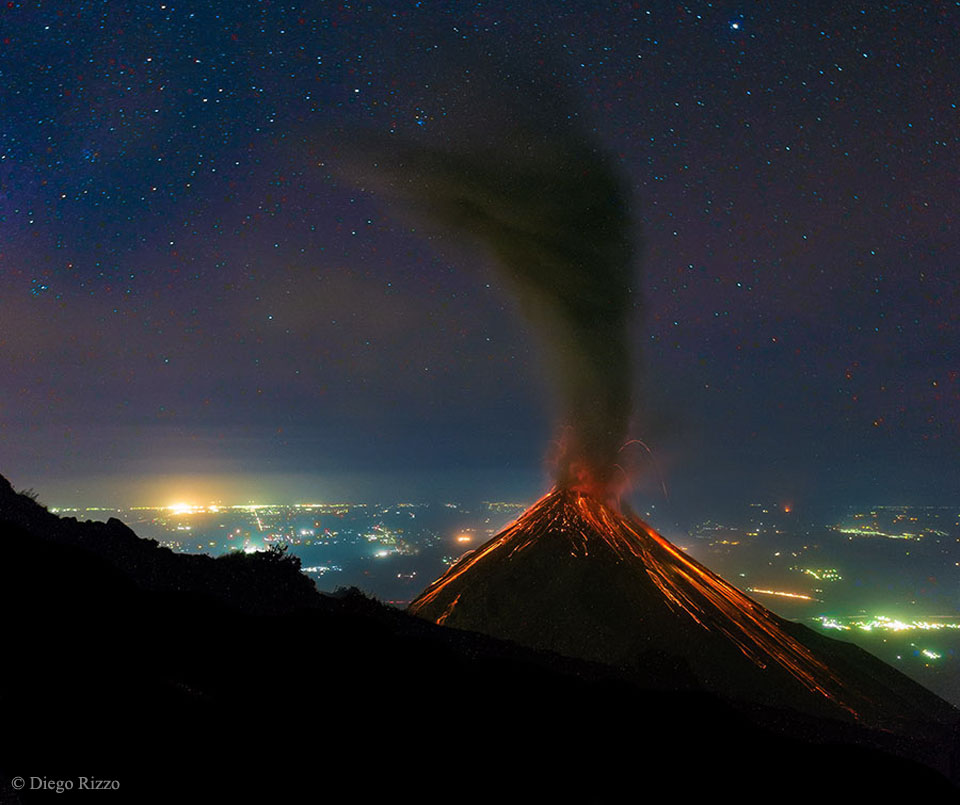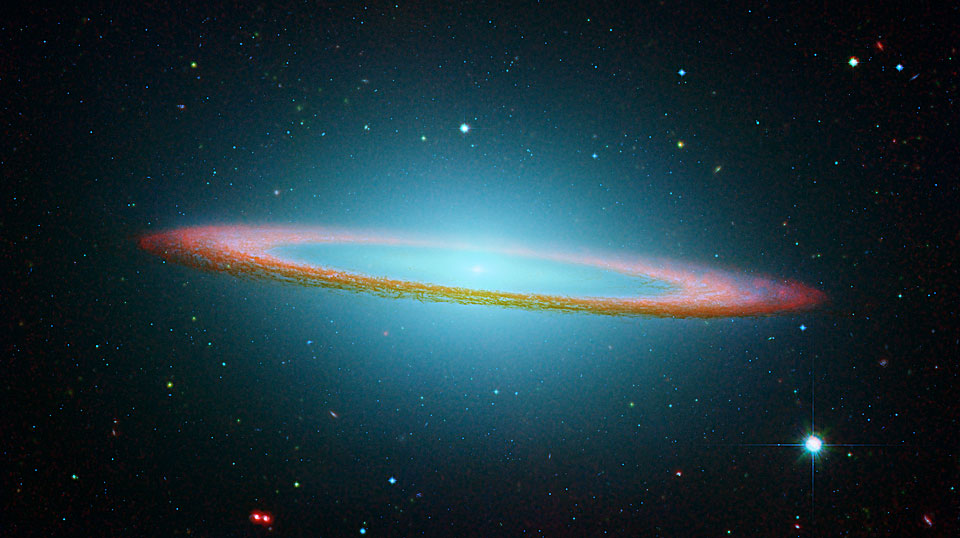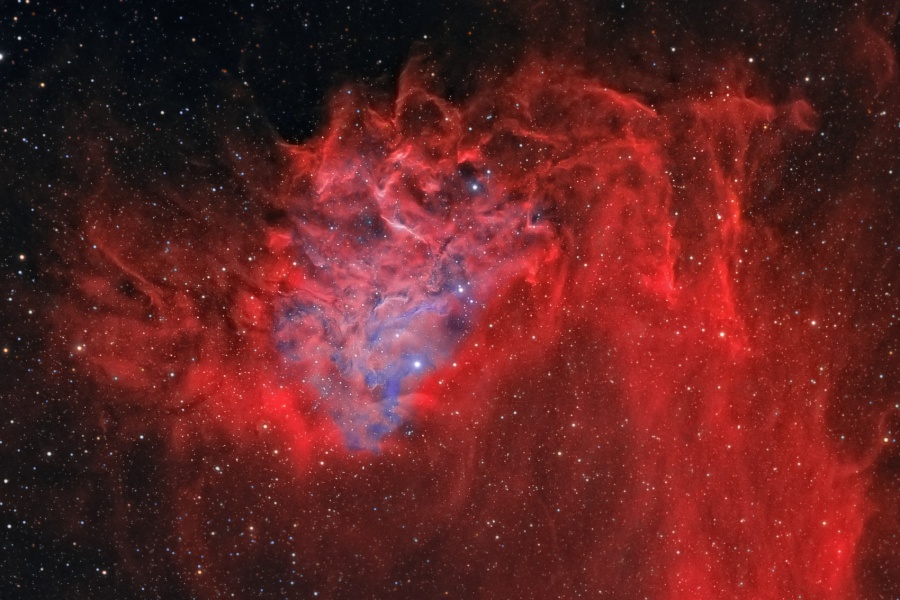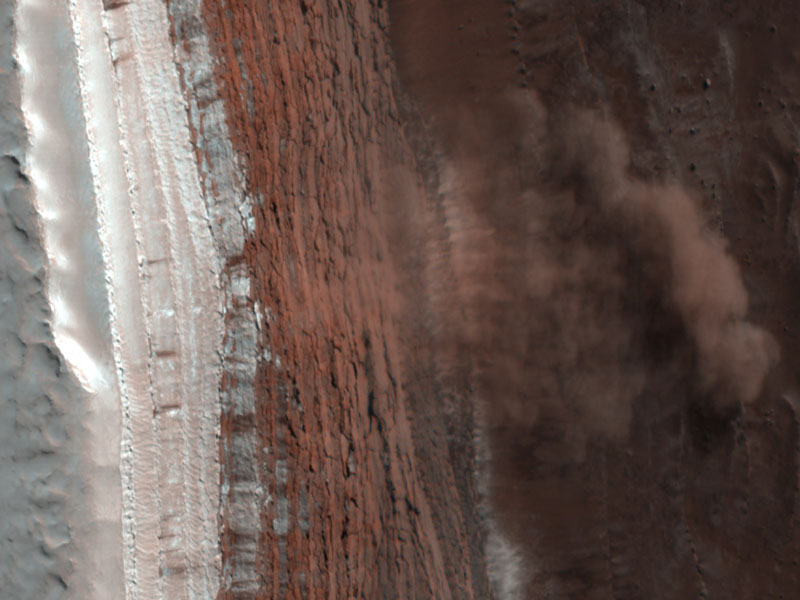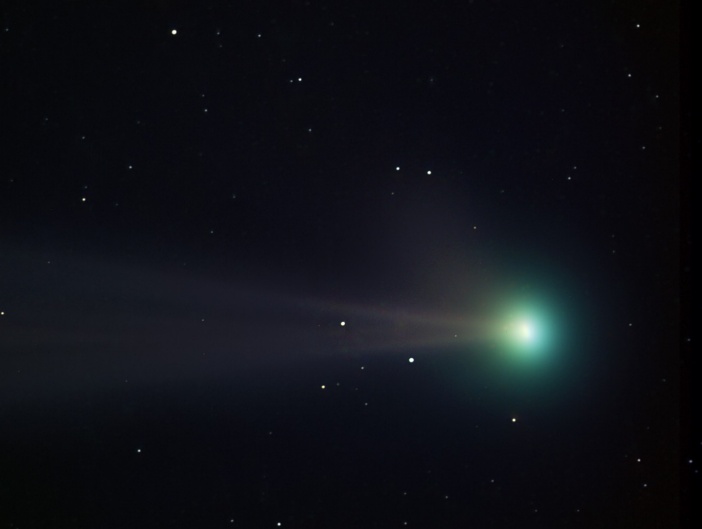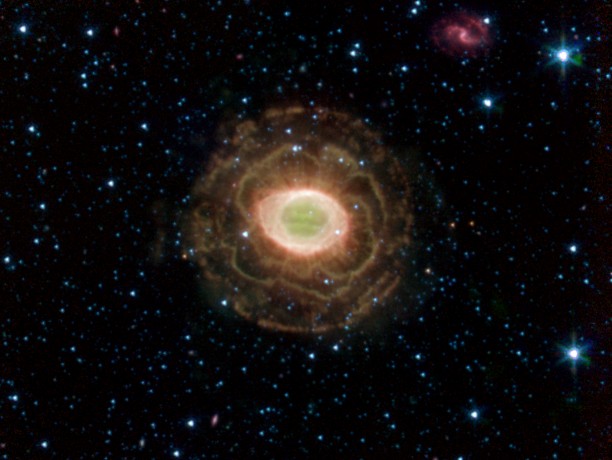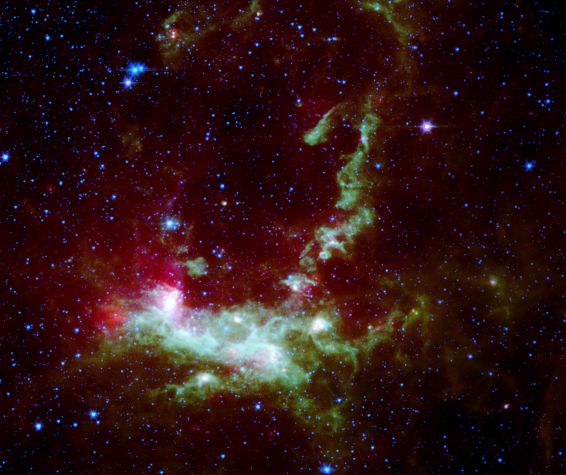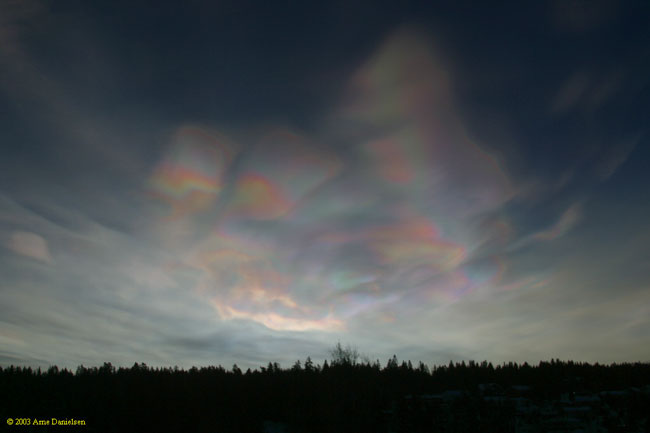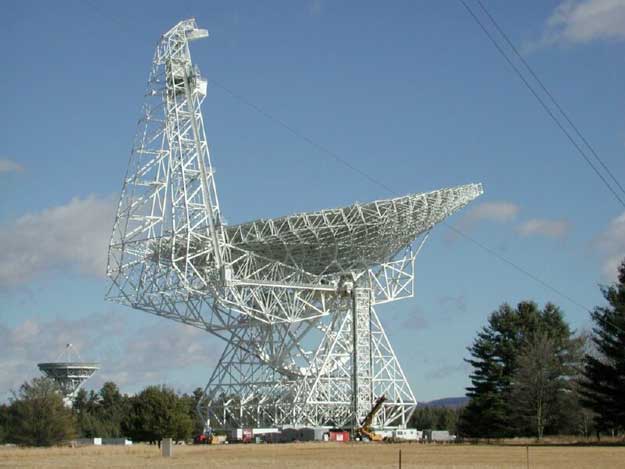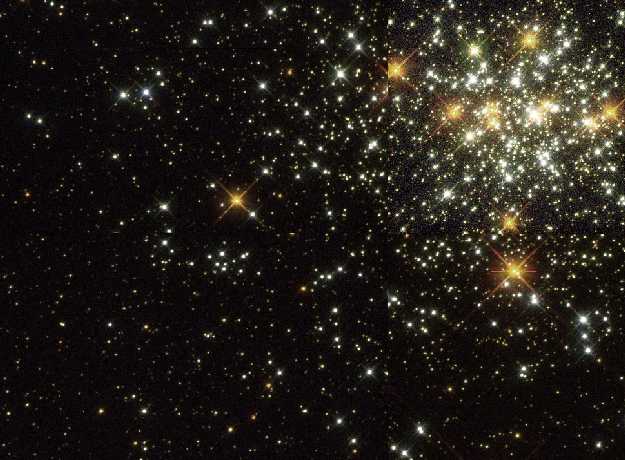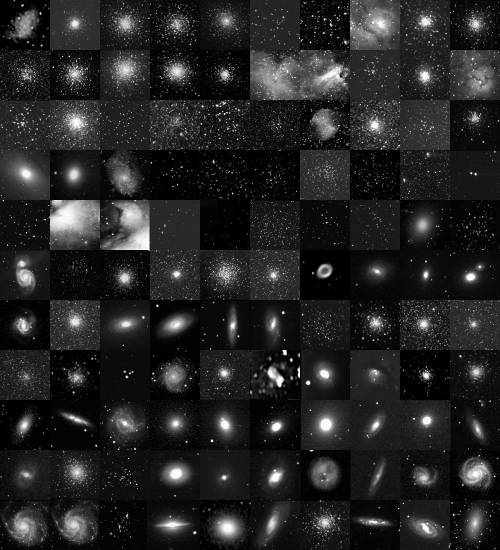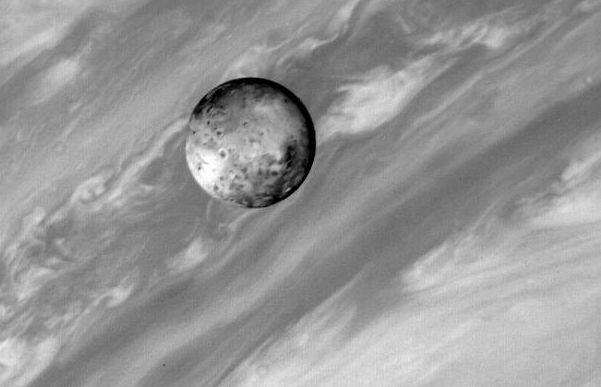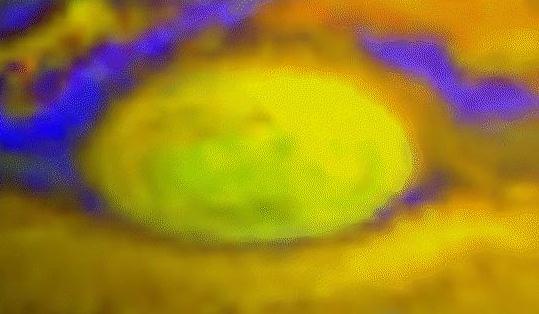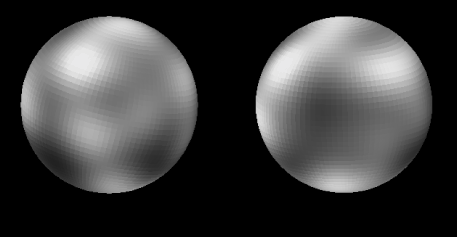| << Previous | Index | Next >> |
2015 First, there was an unusual smell. Then there was a loud bang. But what appeared to the eye was the most amazing of all. While waiting near midnight to see a possible eruption of Volcán de Fuego (Volcano of Fire) in Guatemala last month, a ready camera captured this extraordinary image. Lava is seen running down the side of the volcano, while ash rises up, and glowing magma bubbles explode out of the caldera. Lights near the town of Escuintla can be seen in the background, one of several nearby towns that have witnessed several spectacular eruptions previously. High above, seemingly tranquil by comparison, are familiar stars from the night sky. Although the Volcán de Fuego usually undergoes low-level activity, when the next spectacular eruption will occur is unknown.
2014 In the heart of the Rosette Nebula lies a bright open cluster of stars that lights up the nebula. The stars of NGC 2244 formed from the surrounding gas only a few million years ago. The above image taken in January using multiple exposures and very specific colors of Sulfur (shaded red), Hydrogen (green), and Oxygen (blue), captures the central region in tremendous detail. A hot wind of particles streams away from the cluster stars and contributes to an already complex menagerie of gas and dust filaments while slowly evacuating the cluster center. The Rosette Nebula's center measures about 50 light-years across, lies about 4,500 light-years away, and is visible with binoculars towards the constellation of the Unicorn (Monoceros).
2013 Why does a volcanic eruption sometimes create lightning? Pictured above, the Sakurajima volcano in southern Japan was caught erupting in early January. Magma bubbles so hot they glow shoot away as liquid rock bursts through the Earth's surface from below. The above image is particularly notable, however, for the lightning bolts caught near the volcano's summit. Why lightning occurs even in common thunderstorms remains a topic of research, and the cause of volcanic lightning is even less clear. Surely, lightning bolts help quench areas of opposite but separated electric charges. One hypothesis holds that catapulting magma bubbles or volcanic ash are themselves electrically charged, and by their motion create these separated areas. Other volcanic lightning episodes may be facilitated by charge-inducing collisions in volcanic dust. Lightning is usually occurring somewhere on Earth, typically over 40 times each second.
2012 This floating ring is the size of a galaxy. In fact, it is part of the photogenic Sombrero Galaxy, one of the largest galaxies in the nearby Virgo Cluster of Galaxies. The dark band of dust that obscures the mid-section of the Sombrero Galaxy in optical light actually glows brightly in infrared light. The above image, digitally sharpened, shows the infrared glow, recently recorded by the orbiting Spitzer Space Telescope, superposed in false-color on an existing image taken by NASA's Hubble Space Telescope in optical light. The Sombrero Galaxy, also known as M104, spans about 50,000 light years across and lies 28 million light years away. M104 can be seen with a small telescope in the direction of the constellation Virgo.
2011 AE Aurigae is the bright star below and left of center in this evocative portrait of IC 405, also known as the Flaming Star Nebula. Embedded in the cosmic cloud, the hot, variable O-type star energizes the glow of hydrogen along convoluted filaments of atomic gas, its blue starlight scattered by interstellar dust. But AE Aurigae wasn't formed in the nebula it illuminates. Retracing the star's motion through space, astronomers conclude that AE Aurigae was probably born in the Orion Nebula. Close gravitational encounters with other stars ejected it from the region, along with another O star, Mu Columbae, over two million years ago. The runaway stars have drifted in opposite directions ever since, separating at about 200 kilometers per second. This sharp, detailed image of IC 405 spans over 5 light-years at the nebula's estimated distance of 1,500 light-years in the northern constellation Auriga, the Charioteer.
2010 Fixed to a tripod, a camera can record graceful trails traced by stars as planet Earth rotates on its axis. But at high latitudes during March and April, it can also capture an aurora shimmering in the night. In fact, the weeks surrounding the equinox, in both spring and fall, offer a favorable season for aurora hunters. The possibilities are demonstrated in this beautiful moonlit vista from northwestern Canadian territory the Yukon. It was taken during the early morning of March 1, off the Klondike Highway about 60 kilometers south of Dawson City. To compose the picture, many short exposures were digitally combined to follow the concentric star trail arcs while including the greenish auroral curtains also known as the northern lights.
2009 The striking X near the center of this lunarscape is easily visible in binoculars or a small telescope. Yet, not too many have seen it. The catch is, this lunar X is only apparent during a four hour period just before the Moon's first quarter phase. At the terminator, or shadow line between lunar day and night, the X illusion is produced by a configuration of the craters Blanchinus, La Caille and Purbach. Near the Moon's first quarter phase, an astronaut standing close to the craters' position would see the slowly rising Sun very near the horizon. Temporarily, the crater walls would be in sunlight while the crater floors were still in darkness. Seen from planet Earth, contrasting sections of bright walls against the dark floors by chance look remarkably like an X. This sharp image of the Lunar X was captured at approximately 11:59 UT on March 3, 2009. The Moon's first quarter phase was at 7:46 UT on March 4.
2008 What caused this sudden cloud of dust on Mars? An avalanche! The first avalanche imaged in progress on another planet was recorded last month on Mars by NASA's robotic Mars Reconnaissance Orbiter. Visible in the above picture, digitally rescaled, are several layers of white ice thawing over red rock, with darker colors toward the right indicated Martian soil that mixed with lesser amounts of ice. As the cliff of over 700 meters high was thawing, falling ice crashed down raising plumes of ice and dust so thick they cast visible shadows. The scarp has slopes with grades greater than 60 degrees. The entire scene is illuminated from the upper right by the Sun. A thaw occurs each spring in the Northern Hemisphere of Mars, as the warming climate causes solid carbon dioxide ice to sublimate directly to vapor. Studying such avalanches allows planetary geologists to better understand soil configurations on Mars.
2007 Most galaxies have a single nucleus -- does this galaxy have four? The strange answer leads astronomers to conclude that the nucleus of the surrounding galaxy is not even visible in this image. The central cloverleaf is rather light emitted from a background quasar. The gravitational field of the visible foreground galaxy breaks light from this distant quasar into four distinct images. The quasar must be properly aligned behind the center of a massive galaxy for a mirage like this to be evident. The general effect is known as gravitational lensing, and this specific case is known as the Einstein Cross. Stranger still, the images of the Einstein Cross vary in relative brightness, enhanced occasionally by the additional gravitational microlensing effect of specific stars in the foreground galaxy.
2006 Comet Pojmanski flew by planet Earth last weekend on a surprise trip through the inner solar system. Then an easy binocular target for morning skygazers, Pojmanski ultimately showed off a long tail, but it also presented some lovely green-blue hues as gas molecules in its tenuous coma and tail fluoresced in the sunlight. Astronomers Adam Block and Jay GaBany recorded this colorful high-resolution view on March 3rd in the darkness just before twilight. The picture spans about one full moon on the sky. Comet Pojmanski (C/2006 A1) is outward bound and fading now, still visible in binoculars for northern hemisphere observers.
2005 The classic appearance of the popular Ring Nebula (aka M57) is understood to be due to perspective - our view from planet Earth looks down the center of a roughly barrel-shaped cloud of gas. But graceful looping structures are seen to extend even beyond the Ring Nebula's familiar central regions in this false-color infrared image from the Spitzer Space Telescope. Of course in this well-studied example of a planetary nebula, the glowing material does not come from planets. Instead, the gaseous shroud represents outer layers expelled from a dying, sun-like star. By chance, spiral galaxy IC 1296 is also visible in the upper right of this Spitzer view toward the constellation Lyra. The central ring of the Ring Nebula is about one light-year across and 2,000 light-years away. However, galaxy IC 1296 much bigger and hence farther away ... about 200 million light-years distant.
2004 Peering into a dusty nebula in nearby galaxy the Large Magellanic Cloud, infrared cameras on board the Spitzer Space Telescope recorded this detailed view of stellar nursery Henize 206 filled with newborn stars. The stars appear as white spots within the swirls of dust and gas in the false-color infrared image. Near the top, the sweeping telltale arcs of a supernova remnant are also visible, expanding debris from the final explosion of a massive star. The proximity of the ancient supernova indicates that the shockwave from that stellar death explosion itself likely triggered the formation of the new generation of emerging stars, compressing the gas and dust within Henize 206 and continuing the cosmic cycle of star death and star birth. At the distance of the Large Magellanic Cloud, about 163,000 light-years, this image covers an area about 1,000 light-years across.
2003 Why would clouds appear to be different colors? A relatively rare phenomenon known as iridescent clouds can show unusual colors vividly or a whole spectrum of colors simultaneously. These clouds are formed of small water droplets of nearly uniform size. When the Sun is in the right position and mostly hidden by thick clouds, these thinner clouds significantly diffract sunlight in a nearly coherent manner, with different colors being deflected by different amounts. Therefore, different colors will come to the observer from slightly different directions. Many clouds start with uniform regions that could show iridescence but quickly become too thick, too mixed, or too far from the Sun to exhibit striking colors. Pictured above, iridescent clouds were photographed over Norway two months ago.
2002 The largest single-dish fully steerable radio telescope began operation in 2000 August in Green Bank, West Virginia, USA. Dedicated as the Robert C. Byrd Green Bank Telescope, the device weighs over 30 times more than the Statue of Liberty, and yet can point anywhere in the sky more precisely than one thousandth of a degree. The main dish is so large that it could house a football game, allowing it to hear even the faint murmurs of quasars located across the universe. Anyone can propose to use the Green Bank Telescope, although formal proposals are reviewed competitively. The Green Bank Telescope's large size and innovative design are allowing it to investigate radio waves emitted from comets, planets, pulsars, distant galaxies, and the distant early universe.
2001 Globular clusters once ruled the Milky Way. Back in the old days, back when our Galaxy first formed, perhaps thousands of globular clusters roamed our Galaxy. Today, there are perhaps 200 left. Many globular clusters were destroyed over the eons by repeated fateful encounters with each other or the Galactic center. Surviving relics are older than any Earth fossil, older than any other structures in our Galaxy, and limit the universe itself in raw age. There are few, if any, young globular clusters in our Milky Way Galaxy because conditions are not ripe for more to form. Things are different next door, however, in the neighboring LMC galaxy. Pictured above is a "young" globular cluster residing there: NGC 1818. Observations show it formed only about 40 million years ago - just yesterday compared to the 12 billion year ages of globular clusters in our own Milky Way.
2000 Gripped by an astronomical spring fever, it's once again time for many amateur stargazers to embark on a Messier Marathon! The Vernal Equinox occurs March 20, marking the first day of Spring for the Northern Hemisphere. It also marks a favorable celestial situation for potentially viewing all the objects in 18th century French astronomer Charles Messier's catalog in one glorious dusk to dawn observing run. This year a bright full moon will interfere with dark skies near the actual equinox, so good nights near new moon for weekend marathoners are March 11/12 and April 1/2. (As an added bonus all the planets in the solar system can be viewed on these dates.) Astronomer Paul Gitto has created this masterful Messier Marathon grid with 11 rows and 10 columns of Messier catalog objects. In numerical order, the grid begins with M1, the Crab Nebula, at upper left and ends with M110, a small elliptical galaxy in Andromeda (lower right). Gitto's images were made with a digital camera and a 10-inch diameter reflecting telescope.
1999 Twenty years ago this month, NASA's Voyager 1 spacecraft flew past Jupiter and its moons. This sharp picture of moon Io against a background of gas giant Jupiter's diffuse swirling cloud bands was recorded by Voyager's camera from a distance of about 5 million miles. Even this early image shows curious round features on Io's surface with dark centers and bright rims more than 40 miles across. Now known to be volcanic in origin, these features were then thought likely to be impact craters, commonly seen on rocky bodies throughout the Solar System. But as Voyager continued to approach Io, close-up pictures revealed a bizarre world devoid of impact craters, frequently resurfaced by volcanic activity. In fact, Io's volcanism is so intense that subsequent Voyager images produced an astounding discovery - the first observed extraterrestrial volcanic eruptions.
1998 On February 26th, it was dark during the day. This total solar eclipse was the last visible from the Americas for this millennium. A total solar eclipse is exciting partly because it is so short. Were Earth's Moon farther away, no total eclipse would occur at all because the Moon would appear too small to block out all of the Sun. Were the Moon much closer to the Earth, the eclipse would last much longer. Oddly, the Sun and Moon have almost exactly the same angular size. Even for well located observers, this creates at most only a very few minutes of totality before the Moon's shadow moves away. During a total solar eclipse in 1919, these few minutes were long enough for scientists to determine that the Sun's gravity bends light from the stars behind it, dramatically confirming the accuracy of a new theory of gravity postulated over 80 years ago.
1997 What happened to Jupiter's Great Red Spot? Operating at a chilly 55 degrees Kelvin, the Galileo Spacecraft's Near Infrared Mapping Spectrometer (NIMS) recorded this composite image of Jupiter's Great Red Spot in late June 1996. Red, green, and blue colors were chosen to represent three different infrared wavelengths detected by the NIMS instrument. The resulting yellowish green appearance of the massive Jovian storm system - a cold, high pressure area 2 to 3 Earth diameters wide - indicates that it lies high above the surrounding cloud features. Blue corresponds to regions where the clouds are relatively thin and the features lie at greater depths.
1996 No spacecraft from Earth has yet explored Pluto but astronomers have found ways of mapping its surface. A stunning map of this distant, diminutive planet, the first based on direct images, was revealed late last week in a Hubble Space Telescope press release. Above are two opposite hemisphere views of the computer constructed map of Pluto's surface (north is up). The grid pattern is due to the computer technique used where each grid element is over 100 miles across. The map is based on Hubble images made when Pluto was a mere 3 billion miles distant. It shows strong brightness variations - confirming and substantially improving upon ground based observations. While the brightness variations may be due to surface features like craters and basins they are more likely caused by regions of nitrogen and methane frost. The frost regions should show "seasonal" changes which can be tracked in future Hubble observations. Yes, Pluto is a planet even though it is only 2/3 the size of Earth's Moon!
| << Previous | Index | Next >> |
